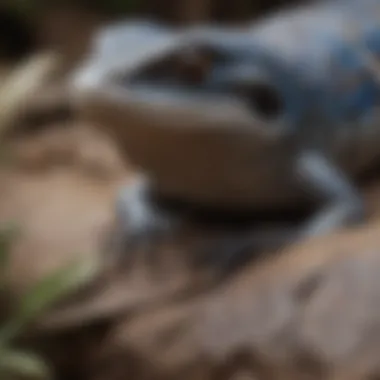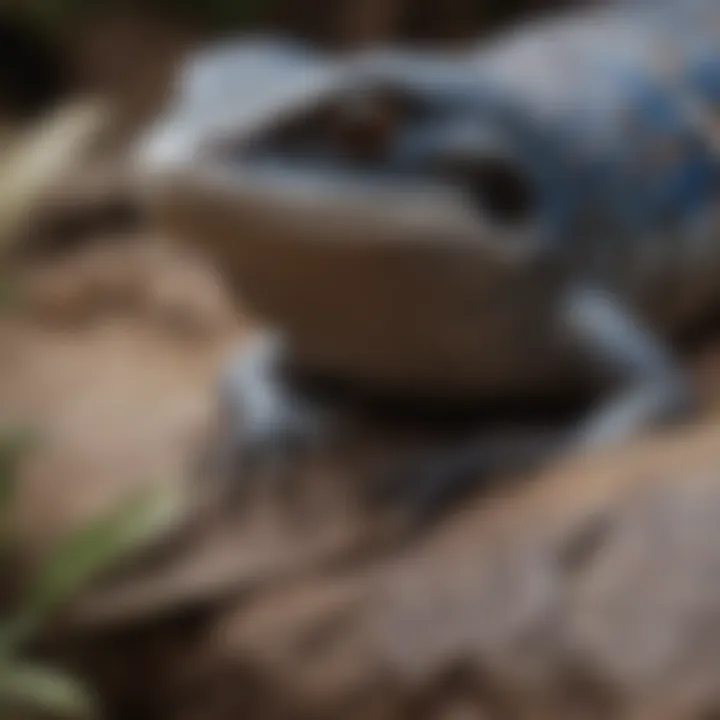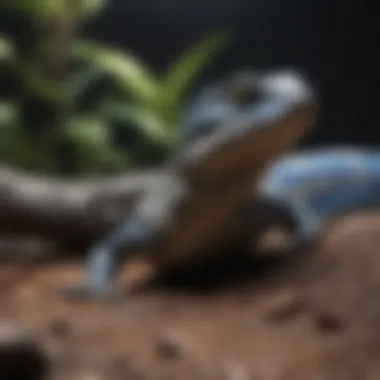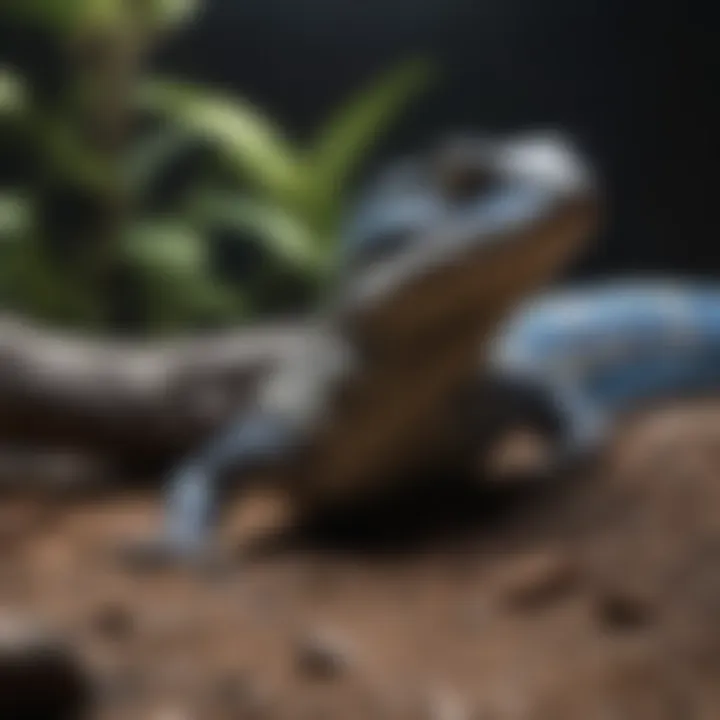Creating the Ideal Blue Tongue Skink Tank for Optimal Care


Intro
Creating a suitable habitat for blue tongue skinks is critical for their health and happiness. These creatures exhibit unique behaviors and requirements that need careful consideration when setting up their tank. This guide aims to provide an insightful analysis of essential factors such as environmental conditions, space, and tank components necessary for sustaining these reptiles.
As you progress through this article, you will learn about various important aspects like substrate selection, heat and lighting sources, and humidity levels—all crucial in mimicking their natural habitat. The insights provided here will equip current and aspiring blue tongue skink owners with comprehensive knowledge to ensure these reptiles thrive.
Care Tips
Daily Care Routines
Daily care for blue tongue skinks involves consistent observation and maintenance practices. Ensure that you monitor their temperature and humidity levels. These reptiles require a basking area around 95°F and a cooler area about 75°F. It's essential to spot clean the tank daily, removing any uneaten food or waste collected in their habitat.
Cage Setup and Maintenance
When setting up the tank, select a spacious container. A minimum size of 40 gallons is recommended for adult blue tongue skinks. The setup should include hiding spots made from logs, rocks, or commercial hides. Consider using reptile carpet or paper towels as substrate, as these are easy to clean and help maintain hygiene.
Besides, the enclosure must provide access to a shallow water dish for hydration. Regularly check the tank for wear and tear, replacing any weak or damaged components immediately.
Hygiene and Cleaning Practices
Maintaining proper hygiene is crucial to prevent disease. Every week, perform a deeper cleaning of the tank. Remove and discard all substrate, clean the glass with a reptile-safe cleaner, and disinfect all accessories. Allow everything to dry thoroughly before reassembling the tank.
Seasonal Care Adjustments
Blue tongue skinks benefit from slight seasonal adjustments in care. Monitor the temperature and humidity levels closely during the colder months, as heating may be necessary. Adjust light cycles to mimic natural changes, potentially using a timer to ensure consistency.
Behavioral Insights
Understanding Body Language
It's vital to observe your blue tongue skink's body language. Their posture, movements, and behavior can indicate their comfort level and health status. A relaxed skink will often display a loose body posture, while stress may result in defensive behavior or hiding.
Common Behavioral Issues and Solutions
Behavioral issues can arise due to environmental stress or improper care. If your skink shows signs of aggression or excessive hiding, check whether their tank conditions meet their needs. Ensure there is adequate hiding spots and environmental enrichment to reduce stress.
Positive Reinforcement Techniques
Utilizing positive reinforcement can encourage desired behaviors. Reward your skinks with a treat when they engage in friendly interactions or come out willingly. This approach strengthens their bond with you and builds trust.
Social Interaction Needs
Blue tongue skinks are generally solitary creatures. However, they can benefit from gentle handling. Spend time interacting with your skink, allowing them to explore while keeping stress levels low.
Nutrition Guides
Essential Diet Components
A well-balanced diet is important for the well-being of blue tongue skinks. Their diet should include a mixture of protein, greens, and some fruit. Suitable protein sources are insects like crickets and mealworms. Leafy greens, such as collard greens and dandelion leaves, should form the primary plant portion of their diet.
Safe and Toxic Foods
While preparing their diet, keep a list of safe foods versus toxic ones. Foods safe for blue tongue skinks include:
- Kale
- Carrots
- Squash
Avoid feeding them items like avocados or onion, as these can be harmful.
Supplements and Treats
Consider providing calcium and multivitamin supplements to ensure proper growth and health. Treats can consist of occasional fruits or insects, given in moderation to maintain a balanced diet.
Feeding Strategies for Different Species
Each blue tongue skink species has slightly varied dietary needs. Research the specific requirements for the type you own. Feeding frequency should be adjusted according to their age and activity level to support their growth.
Wellness and Health
Routine Health Checkups
Regular health checkups are critical. Monitor your skink’s weight, skin condition, and fecal output. Sudden changes in behavior, appetite, or waste should prompt a visit to a veterinarian experienced with reptiles.
Identifying Symptoms of Illness
Be aware of common illness indicators. Lethargy, loss of appetite, or changes in shedding patterns warrant immediate attention.
Preventative Care and Vaccinations
While reptiles do not typically require vaccinations like mammals, preventative care includes maintaining appropriate environmental conditions and diet. Regular health checks aid in early detection of potential issues.
Mental and Emotional Well-being
Mental stimulation is just as essential as physical care. Providing environmental enrichment and interaction opportunities helps in promoting a healthy mindset for your blue tongue skink.
Enriching Activities


Toys and Playtime Ideas
Incorporate various toys or climbing structures in their enclosure, which helps mimic a natural environment. This can include branches or commercially available reptile toys that encourage exploration.
Training and Tricks
Train your blue tongue skink with simple commands. They can learn to associate specific cues or gestures with behaviors, promoting mental engagement.
Outdoor Activities and Interaction
Supervised outdoor time allows for natural sunlight and exploration. Ensure the area is secure and free from potential threats, such as other animals or toxic plants.
DIY Projects for Mental Stimulation
Consider creating DIY projects, such as hideouts or climbing features, for added enrichment. These projects foster curiosity and stimulate their mental capabilities.
Regular care and attention to the environment of blue tongue skinks create a thriving habitat, ensuring their happiness and health.
Understanding Blue Tongue Skinks
Understanding blue tongue skinks is crucial for creating an environment that promotes their health and longevity. These reptiles are unique creatures, and their needs can be quite specific. A solid grasp of their characteristics, natural habitat, and behaviors can help in crafting a suitable tank setup. This knowledge allows owners to provide optimal care, mimicking their native conditions as closely as possible, thereby reducing stress and enhancing well-being.
Species Overview
Blue tongue skinks belong to the family Scincidae. They are known for their distinctive blue tongues, which they display as a defense mechanism. There are several species of blue tongue skinks, including the eastern blue tongue skink and the Indonesian blue tongue skink. Each species may have slight variations in size and coloration, but they share core behavioral traits and habitat needs. Understanding these nuances helps owners appreciate the diversity within the species and their individual requirements.
Native Habitat
In their natural environment, blue tongue skinks are found in various regions, primarily in Australia and New Guinea. They inhabit a range of ecosystems, from forests to grasslands. These habitats often include a combination of dry and moist areas, providing diverse resources. The ground is typically covered in leaf litter, branches, and rocks, which offer hiding spots and protection from predators. The conditions, such as temperature and humidity, vary across their range. Thus, recreating these elements in a tank is essential for their comfort and health, allowing them to exhibit natural behaviors.
Behavioral Traits
Blue tongue skinks are generally calm and inquisitive, making them suitable pets. They tend to be terrestrial, preferring to stay close to the ground. When threatened, they may hiss, open their mouths wide, and display their bright blue tongues as a warning signal. Understanding these behaviors is important for owners as it offers insight into their stress levels and comfort in captivity. Regular observation can help identify when a skink is behaving normally or when it may feel threatened or stressed. Creating an environment that minimizes stress is a key factor in their overall care.
Tank Size and Space Requirements
Understanding the appropriate tank size and space requirements for blue tongue skinks is crucial for their overall health and well-being. An inadequately sized habitat can lead to stress and behavioral issues for these reptiles. Ensuring that the tank provides enough room allows the skink to exhibit natural behaviors, such as exploring, basking, and hiding. A well-planned space can also help in creating appropriate microhabitats within the tank, which is beneficial for the skink’s physical and psychological needs. Consideration of both horizontal and vertical space is essential for mimicking their native environment and promoting a healthy lifestyle.
Minimum Dimensions
The minimum dimensions for a blue tongue skink tank are a key aspect to consider for any owner. Generally, a standard tank size of at least 4 feet long, 2 feet wide, and 2 feet high is recommended for a single adult skink. This ensures they have sufficient floor space to move around and explore. Additionally, for multiple skinks or larger species, increasing the tank size is necessary to prevent territorial disputes and reduce stress levels.
- Space for Activities: Skinks require enough space to engage in various activities, including foraging and basking.
- Avoiding Stress: A cramped environment can lead to anxiety and aggression, which may result in health problems.
It's important to remember that the size of the skink also influences the required tank dimensions. For example, younger skinks can thrive in a smaller setup, but as they grow, their need for space increases significantly. Regular adjustments to the tank size may be needed as they mature.
Vertical Space Considerations
While horizontal space is vital, vertical space should not be overlooked when setting up a tank for blue tongue skinks. These reptiles often enjoy climbing and exploring different levels within their habitat. Providing vertical space can enhance their environment by introducing areas for basking and hiding, catering to their natural instincts. This can be achieved through various means, such as:
- Shelving and Enrichment: Installing shelves or sturdy branches allows skinks to climb, making the tank more stimulating.
- Hiding Spots: Incorporating taller decorations like logs or plants ensures the skinks feel secure, minimizing stress.
Tank Setup Essentials
Creating an appropriate habitat for blue tongue skinks requires careful consideration of various tank setup essentials. These elements contribute significantly to the health and well-being of the skink. A well-structured habitat not only mimics their natural environment but also encourages natural behaviors, which is crucial for their overall quality of life. Key factors to focus on include the tank type, substrate, and decor, each playing a vital role in establishing a suitable living space.
Choosing the Right Tank Type
The tank type is foundational to the skink’s environment. For blue tongue skinks, a glass terrarium is often recommended due to its visibility and ease of maintenance. These tanks come in different sizes, and selecting one that provides ample space is essential.
When considering the tank, light is an important factor. A tank that allows for sufficient lighting can help in maintaining the temperature gradient needed for the skink’s health. Additionally, the structure of the tank should have a secure lid. Skinks are curious and can escape if the enclosure is not properly secured. Choosing a tank made from good quality glass or acrylic will also aid in insulation and temperature retention, which is critical.
Substrate Selection
Selecting the right substrate is another crucial aspect of tank setup. Blue tongue skinks thrive best in a substrate that allows easy digging and provides comfort. Common choices include coconut fiber, aspen shavings, or soil-free mixtures. Each of these options has its benefits.
- Coconut fiber is soft and holds moisture, helping to maintain humidity levels in the tank.
- Aspen shavings are lightweight and good for burrowing.
- Soil-free mixtures provide a safe environment as they do not contain harmful chemicals.
The substrate should be at least two to four inches deep to encourage natural burrowing behavior. Regular cleaning and changing of the substrate are recommended to prevent the growth of mold and bacteria, which can affect the health of the skink.
Decor and Hiding Spots
To create a stimulating environment, incorporating decor and hiding spots is essential. Blue tongue skinks appreciate having access to shelters where they can hide, feel safe, and regulate their body temperature. Items like reptile caves, logs, and rocks can be placed strategically throughout the tank.
Adding live or artificial plants can also enhance the habitat, offering both aesthetic appeal and added hiding spots. Ensure that the decorations are securely placed, as skinks may burrow or push against them.
Creating a habitat that reflects the natural environment of blue tongue skinks fosters healthy behaviors and minimizes stress.
In summary, focusing on the right tank type, suitable substrate, and adequate decor will not only enhance the visual aspect of the blue tongue skink habitat but also promote a thriving living environment. This contributes to the long-term health and well-being of the skink.
Heating and Lighting Requirements
Heating and lighting are crucial components for a blue tongue skink's habitat. These reptiles are ectothermic, which means they rely on external sources to regulate their body temperature. Adequate temperature control ensures your blue tongue skink remains healthy and active, allowing for proper digestion and overall vitality. Without the right heating and lighting setup, skinks can exhibit stress, sickness, or even death. Special consideration is needed in selecting heat sources and UVB lighting to mimic their natural environment effectively.
Heat Sources


When setting up a blue tongue skink tank, the choice of heat sources is paramount. The temperature gradient inside the tank should range from approximately 75 to 95 degrees Fahrenheit (23 to 35 degrees Celsius). Providing a basking area with higher temperatures is essential, as this is where the skink will thermoregulate. Common heat sources include:
- Basking Bulbs: These are effective at creating a localized heat zone. A heat lamp placed above the basking area can raise temperatures efficiently.
- Under-Tank Heaters: Placed underneath the tank, these heat mats help warm the substrate, providing comfort from below. It's crucial that they cover only part of the tank to maintain a temperature gradient.
- Ceramic Heat Emitters: These do not emit light but effectively increase heat levels. They are suitable for night-time use, helping to maintain a warm environment without disrupting the skink's natural day-night cycle.
Ensure that any heat source is positioned safely to avoid burns. It is also vital to monitor temperatures accurately with thermometers, as fluctuations can negatively impact the skink's health. By combining these heat sources properly, you can create the ideal environment for your blue tongue skink.
UVB Lighting
UVB lighting serves as an essential element in a blue tongue skink's habitat. Like heat, proper lighting affects the skink's health and well-being. UVB rays help in the synthesis of vitamin D3, which is necessary for calcium absorption. Without sufficient UVB exposure, skinks are prone to metabolic bone disease and other health complications.
When selecting UVB lighting, consider the following:
- Type of Bulbs: There are fluorescent tubes and compact fluorescent bulbs available. Choose bulbs that emit 5-10% UVB, ensuring it is specifically designed for reptiles.
- Placement: The UVB light should be mounted above the basking area since blue tongue skinks bask in the sun in their natural habitat. Ensure that it is no more than 12-18 inches away from the basking spot, as distance impacts the UV intensity.
- Duration of Exposure: Aim to provide 10 to 12 hours of UVB lighting daily. Using a timer can help maintain a consistent lighting schedule, replicating the day-night cycle.
Proper UVB exposure greatly reduces the likelihood of health issues related to calcium deficiency, making it imperative for the care of your skink.
By paying careful attention to heating and lighting requirements, you help ensure a thriving habitat for your blue tongue skink. This consideration not only supports the skink's physical health but also contributes to its overall behavioral health, making it an essential aspect of appropriate tank care.
Maintaining Humidity Levels
Maintaining the right humidity levels is crucial for the wellbeing of blue tongue skinks. These reptiles originate from areas with specific environmental conditions. Proper humidity helps in digestion, shedding, and overall hydration. A too dry environment can lead to complications such as shedding issues, while excessive humidity can foster bacterial and fungal growth.
It is essential to create a balance that mimics their natural habitat. Ensuring optimal humidity not only contributes to health but also fosters a more active and comfortable creature. Without adequate humidity, skinks may exhibit signs of stress, which can lead to various health problems over time. Thus, understanding humidity needs and how to manage them is fundamental for any skink owner.
Humidity Needs of Blue Tongue Skinks
Blue tongue skinks thrive in a humidity range between 40 and 60 percent. This range varies with their activity levels and the season, requiring adjustments to the tank's conditions. Higher humidity levels are often needed when the skinks are shedding. Maintaining this range can be achieved using various methods.
A large water bowl can be beneficial, as it creates humidity through evaporation. Additionally, misting the tank occasionally will help in raising humidity levels. It is best to monitor the environment closely. If the humidity drops too low, the skink could face health issues, and its behavior may be negatively affected.
Methods for Monitoring Humidity
Monitoring humidity accurately is essential for successful skink care. Various tools can be employed to ensure the levels are correct:
- Digital Hygrometers: These devices provide precise readings and can be placed inside the tank for real-time monitoring.
- Thermo-Hygrometers: These instruments measure both temperature and humidity, making them a two-in-one solution for environmental management.
- Regular Misting: Observing how moisture levels change after misting can help gauge humidity in a more hands-on manner.
Maintaining a balanced humidity level is another aspect of ensuring that blue tongues stay healthy and comfortable. Without careful attention, owners risk creating an environment that fosters health concerns.
"Consistently checking humidity provides peace of mind, ensuring that your blue tongue skinks thrive in a comfortable habitat."
By actively controlling and observing humidity, skink owners can create a thriving and enriching environment conducive to the animal's overall health.
Diet and Nutrition
Diet and nutrition are critical components in the overall care of blue tongue skinks. Understanding the dietary needs of these reptiles allows owners to provide a balanced and healthy diet, significantly affecting their growth, longevity, and quality of life. Proper nutrition can help in preventing common health issues, optimize metabolic functions, and enhance overall vitality. Skinks are omnivores, leading to a variety of dietary options, but it is essential to know the right balance of nutrients and how to incorporate them into their feeding routine.
Essential Nutritional Elements
Blue tongue skinks require a mix of protein, vitamins, minerals, and fiber to thrive. This necessitates a varied diet. Here are the key nutritional elements:
- Proteins: Necessary for muscle development and repair, proteins should be sourced from high-quality insects such as crickets and mealworms. This can also include small amounts of cooked eggs or lean meats occasionally.
- Vegetables: A large portion of their diet should come from fresh vegetables. Leafy greens like collard greens, dandelion greens, and kale offer important vitamins. Root vegetables should also be included, like carrots and squash, both providing essential nutrients.
- Fruits: While fruits should be given only occasionally due to their high sugar content, options like berries and melons can be beneficial in moderation.
- Calcium and Vitamins: Calcium is crucial for bone health. A calcium supplement should be dusted on their food a few times a week. Alongside calcium, a vitamin supplement containing Vitamin D3 is also recommended to promote proper absorption and utilization of calcium in the body.
Maintaining a diverse diet helps ensure that blue tongue skinks receive the necessary nutrients for their health. It is also advisable to avoid foods that can be harmful, such as citrus fruits and iceberg lettuce, which provide little nutritional value.
Feeding Schedule
Establishing a consistent feeding schedule plays a vital role in the health of blue tongue skinks. Here are the main considerations:
- Frequency: Adult skinks typically benefit from feeding every other day, while younger skinks may require daily feedings. Adjust the meal size accordingly based on their age and activity level.
- Portion Control: Monitor the amount of food vs. your skink's size. A good rule is to feed an adult skink approximately 10-15% of its body weight in food per feeding.
- Timing: It’s best to feed during the evening or late afternoon, as blue tongue skinks are generally more active during these times. This mimics their natural foraging behavior.
- Observation: Pay attention to your skink's eating habits. A lack of interest in food can indicate possible health concerns. Regular observation helps catch any sudden changes in appetite.
Incorporating these dietary insights will not only meet the nutritional needs of blue tongue skinks but will also create a feeding strategy that aligns with their natural behavior. It ultimately leads to a healthier and happier pet.
"A balanced diet is essential for optimal health in blue tongue skinks; neglecting diet can lead to serious health issues."
Tank Maintenance Practices
Maintaining a clean and healthy environment is crucial for the wellbeing of blue tongue skinks. Regular maintenance not only ensures that the habitat remains suitable but also prevents potential health issues that can arise from neglect. Effective tank maintenance involves several specific practices, which include routine cleaning procedures and monitoring health indicators. Each of these plays an essential role in fostering a vibrant ecosystem within the tank and promoting the overall health of the skinks.
Routine Cleaning Procedures
Establishing a regular cleaning routine is vital for keeping the tank and its inhabitants in good condition. The cleanliness of the habitat directly affects the skinks’ health and comfort. Here are the key components of an effective cleaning regime:
- Weekly spot cleaning: Removing uneaten food, waste, and debris should be done weekly. This helps in preventing the buildup of harmful bacteria and maintains overall hygiene.
- Monthly deep cleaning: A more thorough cleaning should take place monthly. This involves removing all decorations, cleaning the substrate, and disinfecting the walls of the tank. Always use safe cleaning products that do not leave harmful residues.
- Substrate changes: Depending on the type of substrate used, it may need to be changed every month or so. This will help to maintain freshness and minimize odors.
- Water changes: If using a water dish, keep it fresh by changing the water daily. Ensure the dish is cleaned regularly, especially if it gets soiled.
Cleaning not only promotes a healthier living space for the skinks, but it also allows their owners to observe any changes in behavior or health issues that may require attention.
Monitoring Health Indicators
Another significant aspect of tank maintenance is monitoring the health of blue tongue skinks. Keeping an eye on their health indicators can aid in early detection of problems. Key indicators to watch for include:
- Behavioral changes: Any sudden shift in behavior, such as lethargy or a decrease in appetite, can signify stress or illness.
- Physical appearance: Regularly check for signs of shedding issues or skin abnormalities. Healthy skin should be clear and soft, not discolored or flaky.
- Temperature regulation: Ensure the tank’s temperature gradient allows the skink to thermoregulate efficiently. Sudden temperature fluctuations can cause stress.
- Fecal analysis: Monitoring the type and consistency of feces can provide insight into the skink's digestive health. Normal feces should be firm and well-formed.
Regular monitoring enables timely intervention. Quick response to any observed issues can significantly impact the recovery of the skink if illness occurs.
Combining regular cleaning with careful observation of the skinks' behaviors and physical conditions will help create a thriving environment. This ultimately leads to healthier, happier blue tongue skinks.


Enrichment and Interaction
Providing enrichment and promoting interaction are crucial for the well-being of blue tongue skinks. These reptiles are naturally curious and benefit from a stimulating environment that mimics their native habitat. Enrichment comes from physical structures, toys, and activities that encourage natural behaviors. Interaction with their owners can also enhance their quality of life, fostering a bond that promotes healthy development.
Toys and Accessories
Incorporating toys and accessories within the tank is essential for mental stimulation. Blue tongue skinks enjoy exploring their surroundings and will readily engage with a variety of items. Here are some considerations:
- Hideouts: Providing multiple hiding spots allows skinks to retreat and feel secure. This can be as simple as cardboard boxes or commercially available reptile hides.
- Climbing Structures: Branches or logs can provide climbing opportunities, simulating their natural habitat. This adds vertical exploration, which can be rewarding.
- Water Features: A shallow water dish encourages bathing behaviors, which is vital for skin health. Changing the water frequently keeps it clean and appealing.
- Interactive Toys: Simple balls or soft objects that can be pushed around are also stimulating. Be cautious, ensuring they are safe and cannot be ingested.
- Natural Elements: Incorporating leaves, stones, or other natural items can make the enclosure feel more like their native environment, improving overall enrichment.
These toys not only help in keeping your blue tongue skink entertained but also aid in physical exercise, thus promoting overall health.
Safe Handling Techniques
Proper handling is vital for the relationship between owners and blue tongue skinks. Stress can result from improper handling or frequent disturbances. Here are some strategies for safe handling:
- Approach Slowly: Always approach your skink calmly. This reduces anxiety. You may allow the skink to see your hand before picking it up.
- Support Their Body: When lifting your skink, support its entire body. Use your other hand to prevent any sudden movements that may startle them.
- Limit Duration: Initially, handling sessions should be brief. Gradually increase the duration as your skink becomes more comfortable.
- Avoid Feeding During Handling: Try not to handle the skink just before or after feeding, as this can lead to stress and potential injuries.
- Establish a Routine: Handling regularly helps acclimate your skink to your presence. A consistent routine means less fear and a more relaxed pet.
Adopting safe handling practices promotes trust and can make caring for your blue tongue skink a gratifying experience.
"A well-handled skink is more likely to exhibit calm behaviors, making interaction more enjoyable for both the pet and owner."
Common Behavioral Issues
Understanding common behavioral issues is crucial for ensuring the well-being of blue tongue skinks. Behavioral traits often indicate how a skink is adjusting to its environment. Recognizing these signs early can prevent more serious health problems and improve the reptile's overall quality of life. By identifying stress signals or aggression tendencies, owners can find ways to enhance their skink's habitat and social conditions, promoting a more harmonious existence.
Signs of Stress in Blue Tongue Skinks
Stress in blue tongue skinks manifests through various behaviors. Noticing these signs helps owners intervene before a situation escalates. Some common signs include:
- Hiding: Frequent hiding can indicate that a skink feels threatened or insecure. If the skink takes refuge under substrate or in decor, this signals discomfort.
- Aggressive Posture: If the skink displays an open mouth or hissing, it may be feeling cornered or panicked.
- Decreased Appetite: A lack of interest in food can be a clear sign of stress in reptiles. If the skink refuses meals for several days, it needs evaluation.
- Escape Attempts: Persistent attempts to escape from the tank can point to an unsuitable environment or lack of enrichment.
Monitoring these signs allows owners to gauge the skink's emotional state and physical health. Creating an accommodating habitat with proper hiding places and enrichment can alleviate many stressors.
Addressing Aggression or Fear
Addressing aggression or fear in blue tongue skinks is essential for a peaceful coexistence. Factors contributing to these behaviors may include lack of hiding spaces, improper socialization, or environmental stressors. Owners can implement several strategies to mitigate these issues:
- Safe Spaces: Ensure the habitat includes sufficient hiding spots that are easily accessible. Providing options allows skinks to feel secure and reduces stress.
- Gradual Introductions: If introducing multiple skinks, do so gradually. Sudden introductions can lead to aggressive behaviors as they assert territorial claims.
- Gentle Handling: When handling, do so gently and confidently. Sudden movements can trigger a fear response. It is helpful to approach the skink slowly to build trust.
- Environmental Adjustments: Alter factors like lighting or temperature if the skink appears consistently aggressive or fearful. An uncomfortable environment can exacerbate these behaviors.
Creating a stress-free environment significantly improves the behavioral traits of blue tongue skinks, promoting a secure and enjoyable habitat.
Addressing these issues proactively allows owners to support their skink's emotional health, which is as vital as addressing physical care.
Health Considerations
Understanding and addressing the health of blue tongue skinks is vital for their long-term wellbeing. Proper care ensures that these reptiles live healthy and fulfilling lives. The significance of health considerations revolves around recognizing common health issues and implementing practices that prevent problems before they arise.
Blue tongue skinks can experience various health challenges that stem from their environment, diet, and handling. Acknowledging these issues not only helps keep your skink healthy but also contributes to the stability of the habitat you create. As responsible caretakers, it is our duty to ensure these reptiles thrive in captivity, mirroring their natural conditions as closely as possible.
Common Health Problems
Blue tongue skinks may face several health issues, and being aware of these can assist in early detection and treatment. Common problems include:
- Respiratory Infections: These are typically caused by poor humidity levels or inadequate thermal gradients in the tank, leading to breathing difficulties.
- Metabolic Bone Disease (MBD): A lack of proper calcium and UVB light exposure can result in MBD, which affects the skink’s bone health.
- Parasites: Internal and external parasites can negatively impact the health of blue tongue skinks, leading to weight loss and overall weakness.
- Obesity: Overfeeding can lead to obesity, which can further result in other health complications.
Identifying these issues early can help in formulating a sound treatment plan.
Preventative Care Strategies
To reduce the risk of health problems, implementing preventative care strategies is essential. Here are some key practices:
- Regular Veterinary Check-ups: Schedule routine visits with a reptile vet. This ensures early detection of any health issues.
- Proper Diet: Maintain a balanced diet that includes a variety of vegetables, fruits, and protein sources. Understanding nutritional needs is crucial for their health.
- Environmental Maintenance: Regularly monitor and adjust tank conditions. Pay attention to humidity and temperature to avoid respiratory problems.
- UVB Lighting: Ensure adequate UVB exposure to prevent metabolic bone disease. This is essential for calcium absorption and overall health.
- Hygiene Practices: Keep the tank clean. Removing waste promptly and maintaining a sanitary environment will limit the risk of infections.
- Behavioral Observation: Watch for any changes in behavior. If the skink appears lethargic or is not eating, seek advice from a vet promptly.
"A healthy blue tongue skink is a happy skink. Recognizing problems early and providing proper care can make all the difference."
By adhering to these strategies, the risk of health complications can be significantly reduced. Maintaining a focus on regular care enables blue tongue skink owners to provide environments that support healthy, active reptiles.
Culmination
In synthesizing the essential elements of establishing a suitable tank for blue tongue skinks, it is vital to recognize the multifaceted needs of these reptiles. A proper environment not only ensures their physical health but also encourages natural behaviors, reducing stress and promoting overall well-being. Therefore, addressing components like tank size, substrate, temperature, and humidity forms the foundation of effective care.
Key considerations arise from various areas discussed in this article. The significance of space cannot be understated, as blue tongue skinks require ample room to move and explore. Moreover, maintaining the appropriate heating and lighting plays a crucial role in replicating their native habitat. These elements intertwine, creating a space where the skinks can thrive.
Additionally, diet and enrichment practices are important for comprehensive care. A well-structured feeding schedule, alongside engaging activities, supports their mental stimulation and physical health.
"Creating the ideal habitat requires attention to each component, intertwining behavioral needs with environmental factors."
Ultimately, understanding the intricate details outlined helps ensure a harmonious life for your blue tongue skink. Such diligence not only fosters a vibrant atmosphere but also encourages a bond between the owner and reptile. A balanced approach ultimately leads to a fulfilling experience for both.
Summary of Key Takeaways
- Space Matters: Ensure tank size accommodates natural movement and exploration.
- Temperature and Lighting: Replicate native conditions to support health and behavior.
- Nutrition: Offer a balanced diet with a consistent feeding routine.
- Enrichment: Include toys and hides to promote natural behaviors and reduce stress.
Being informed about these critical aspects enables pet owners to create a thriving environment that mirrors the skink's natural habitat, improving not only their pet's quality of life but also enhancing the owner's experience.
Final Thoughts on Blue Tongue Skink Care
Care for blue tongue skinks should be seen as a blend of art and science. Understanding specific needs allows owners to make informed decisions that directly impact their pets' health and happiness. The ideal tank is more than just a containment space; it is a carefully curated environment that simulates natural conditions.
As you move forward with building the perfect habitat, keep in mind that each skink is unique. Observing their behavior and responding to their needs creates a symbiotic relationship. Furthermore, seek continual education on care techniques and habitat enhancements. This ongoing adaptation leads to a successful crafting of a blue tongue skink’s home that not only meets their biological requirements but also enriches their experience.
Engaging with communities on platforms like Reddit or Facebook can offer additional insights and support. The journey of caring for these remarkable creatures is ongoing. As you continue to learn and adapt, your blue tongue skink will benefit immensely from your efforts.















